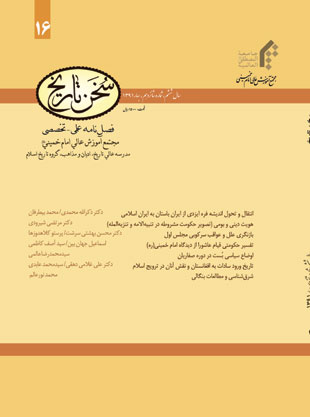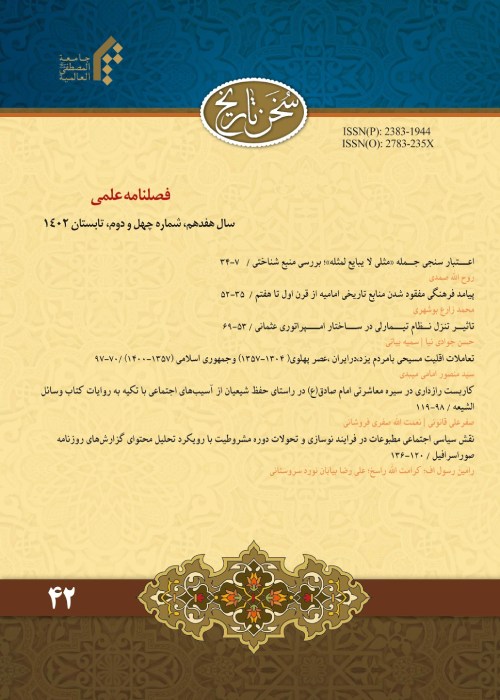فهرست مطالب

نشریه سخن تاریخ
پیاپی 16 (بهار 1391)
- تاریخ انتشار: 1391/04/04
- تعداد عناوین: 7
-
صفحه 119
-
صفحه 177
-
Page 3Transferring the theory of Farr-i Izadi from ancient Iran to Islamic era of Iran is one the most important components that helped in formation of the theory “Ideal King” in Islamic era. Numerous papers have been written on Farr-i Izadi,however few works have been done on reproduction and changes of Farr-i Izadi in Islamic era of Iran, and yet in general review no comprehensive research has ever been done so far. In the present paper we tried to explain political thought Farr-i Izadi in earlier Islamic era in Iran, i.e. invasion of Muslim Arabs to invasion of Mongols, based on Iranian scholars’ trends of thought. It is quite obvious, the entrance of Islam in Iran gave Islamic approachesto methods of ruling, so that the first Iranian governmentswere seeking historical –mythological ancestry,in order to receive Farr-i Izadi (divine glory),and alsoallegiance to Caliph represented their legitimacy. But such legitimacy was somehow different from general structure of Farr-i Izadi in public opinion. As it is described in the present paper, the allegiance which represents legitimacy was considered the crucial difference between Sultan and Caliph. With the emergence of Turks in political system of Iran,seeking genealogy charts for Iranian kings was abandoned and this intellectual change of scholars led to the first intellectual dissociation in Iranian society.Keywords: Farr, i Izadi, Sultan, Caliph, bureaucracy, political thought, justice
-
Page 37The image of religious government in semantic system of Ayatollah Na’iniwill be explained in the present article. As a matter of fact, he tried to give an Iranian – Islamic identity to modern political concepts, such as constitutional governments, in the framework of Sharia (legislation),through Ijtihadand imposing modern definitionsto traditional concepts. Although his idea faced criticism at that time and afterwards, at least it involvedsome pointswhich are effective in stability and dynamicof newly established Islamic Republic government. In the present paper religious constitutional government of Ayatollah Na’ini is illustrated and it prepares the ground for understanding Islamic democrat rules in the Islamic Republic government of Iran.Keywords: Ayatollah Naini, identity, constitutional, religious government, “Tanbihul, Umma wa Tanzihul Milla
-
Page 61The events of Ramadan in 1322 (A.H) that led to movements of liberals in Iran is considered the beginning of change from dictatorship government to Constitutional monarchy.This situation also made grounds for speakers and clergymen to play their role. Eventually after immigration of Clergymento Qom in order to show their protests and by support of people,Mozaffar-al- Din Shah Qajar agreed the constitutional monarchy in 1324 (A.H).He died 10 days later and Muhammad Ali Mirza, his son, came to power. He revealed his disapproval toward constitutional monarchy inhis coronation ceremony; he also did not invite any of Majlis (Parliament) members. Muhammad Ali Shahwas trying to revive the autocratic power of Qajar and he was dreaming of monarchy ruling of his grandfather, Naser-al-Din Shah. Although he pretended to support the Majlis, he made it weak and weaker. Eventually in the 2ndday of Tir in 1278 (A.H solar years) he ordered to set artillery fire against Majlis. The situation in which the constitutional government established, Muhammad Ali Shah’s attitude toward Majlis, disagreements between Shah and Majlis, coup d’état in 1287 (A.H), the inner situations of Majlis before and after 1287 coup d’état and the reasons that led to dissolving of the first Majlis will be analyzed through the present paper.Keywords: The first Majlis, Muhammad Ali Shah, constitutional revolution, legitimacy, Suppression
-
Page 91Numerous studies and researches have been done on uprising and movement of Hussein ibn Ali. And one of the main subject in the present paper is Hussein ibn Ali’s goal in Ashura uprising. There is no doubt that uprising against the tyrant ruler, restoring the rights,promotion of virtue and prevention of sin (Amre be marrof wa nahye az monkar), establishing justice and reviving Sunnahwere the main goals of Hussein ibn Ali, but the question is, did he leave Medina to Kufa in order to establish a government or he was seeking martyrdom? Islamic revolution in Iran and establishment of Islamic republic government leading by Ayatollah Khomeini,14 centuries after historical and influential Ashura uprising, considered inspired by the divine act of Hussein ibn Ali. Ayatollah Khomeini considered Ashura uprising a motive which led the Islamic revolution of Iranto victory. He also had studied and analyzed Ashura uprising, and he believed Hussein ibn Ali left Medina to Kufa in order to establish a government.Keywords: Hussein ibn Ali, Ashura uprising, Ayatollah Khomeini, Government, movement, Kufa
-
Page 119Bost played a crucial role in establishment and stability of Saffarid dynasty. At the end of Tahirid era, Bost had a chaotic situation and different groups tried to take control of the city. Yaqub Leith,one of the Ayyaran, came over his opponents and took bay’ah (Oath of allegiance) from people. Then he suppressed his opponents among his former friends and Kharijites and took actions outside of Sistan. At first he overthrown Tahirid dynasty,afterward he attacked Bagdad, the capital of Abbasids. After the death of Yaqub Leith,vaulting ambitions of Saffarid dynasty declined. In Saffarid era, Bost was considered a vital city in which most of the major decisions, such as choosing Saffarid governors, were made. At the end of Saffarid era, Samanid dynasty took control of Bost. Khalaf ibn Ahmad Saffari’s attempts failed in regaining the control over Bost. Eventually this city was conquered by Ghaznavids.Keywords: Bost, Sistan, Ayyaran, Saffarid
-
Page 141Sayyids of Afghanistan,like other descendant of Prophet Muhammad, have clear cultural identity and historical background. In the present paper,based on historical evidences and documents, the time of entrance of Sayyids in Afghanistan and their role in promotion of Islam will be analyzed. There have been different discussionsabout the entrance of Sayyids in Afghanistan, and the most important ones are related to the reasons of their migration to cities like Balkh and Herat. Categorizing the Sayyids as a matter of time, from beginning of 2nd century to 7thcentury is another topic of present paper. Also most of the Sayyids settled in Balkh and Herat, two important cities of Afghanistan. In addition, a relative opinion says Hosseini Sayyids attributed to Ali ibn Hussein and Mousavi Sayyids are attributed to Musa al Kadhim. Sayyids’ role in promoting Islam is a main topic of the present paper. They had a magnificent role in culture, science, opinionative and Islam promotion-related areas. In addition to the written sources,the present paper mentions other kinds of evidences which indicate the presence and entrance of Sayyids in Afghanistan. The present topic was not considered so much a decade ago, and no book and paper has been published on the entrance of Sayyids in Afghanistan. But since 1380s (A.H solar years) numerous researches have been done on this area. The present paper has been done based on library sources.Keywords: Sayyids, descendants, Afghanistan, Balkh, Herat
-
Page 177The meaning and concept of the term orientalism, has changes through periods of time. The term, Orientalism appeared since the Mediterranean Sea considered the center of the world in recent centuries, and the geographical directions were determined based on it; also the researches who were studying on the Orient were called orientalist. Considering the fact that mostly Muslims were settling on the major east parts of Mediterranean Sea, the researchers who were studying on them were also called orientalist. There have been numerous discussions on the goals of western researchers, who were studying on the Orient, and many reasons were mentioned so far. After a quick analysis, we can conclude some of their assertions are true. The present paper is written in two complimentary parts. The first part is including generalities on orientalism and the second part is about Bengal studies in different eras. Bengal is an ancient and historical land which Muslims conquered at the end of the 6th century (A.H). The Turks, Mongols and Britain were also ruling over Bengal through history. Bengal studies and introducing this land began in the 3rd century (A.H) by a well-known writer, Suleiman the Merchant followed by Abū Rayḥān al-Biruni, khordadbeh,Masudi and Edrisi. These studies continued by Marco Polo in the 7th century (A.H) and Ibn Battuta in the 8th century. Afterwards, Muslim historians and geographers made a great effort in introducing the culture, history and civilization of Bengal. Bengal studies began among Chinese in the 15th century. But the western researchers began their studies on Bengal in the 16th century. The Britain totally dominated India in the middle of the 18th century, and in order to proceed with their orientalist goals, they establish Fort William College in Calcutta. Eventually their plans failed by missionary groups, because it led to awakening of Bengal intellectuals. In the last decades of colonial rule of Britain in India, Bengal studies extended by Bengali people themselves, and it led to establishment of department, associations and institutes in universities and publishing books and journals. Meanwhile prominent Bengal figures made a great effort to give profundity and acceleration to these studies. Currently Bengal Studies continued in personal and academic researches in different universities around the world.Keywords: Orientalism, Bengal, Studies, the British east India Company, FortWilliam College


